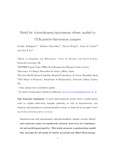Model for (a)synchronous/spontaneous release, applied to CCK-positive Interneuron synapses
| dc.contributor.author | Rodrigues, S | en |
| dc.contributor.author | Desroches, M | en |
| dc.contributor.author | Krupa, M | en |
| dc.contributor.author | Cortes, J | en |
| dc.contributor.author | Afia, A | en |
| dc.date.accessioned | 2018-08-13T10:44:23Z | |
| dc.date.available | 2018-08-13T10:44:23Z | |
| dc.date.issued | 2013-08-14 | en |
| dc.identifier.uri | http://hdl.handle.net/10026.1/12023 | |
| dc.description.abstract |
Asynchronous and spontaneous neurotransmitter release remain elusive and constitute topics of considerable research both from the experimental and modeling perspective. This study proposes a parsimonious model that accounts for all modes of vesicle exocytosis and Short-Term Synaptic Plasticity (STSP). The modeling novelty is based on principles of slow-fast dynamical systems theory. The model's validity is shown by its good agreement with experimental data obtained from in vitro electrophysiological dual whole-cell recordings between local cholecystokinin (CKK)-positive, Schaffer collateral associated (SCA) interneurons in the CA1 region of rat hippocampus~\cite{AfiaAli2007,AfiaAli2010}. These unitary synapses display asynchronous release, governed by the retrograde release of endocannabinoid in response to post-synaptic membrane depolarisation. This work will advance our understanding of the physiology underlying differential exocytosis, and facilitate large-scale neuronal simulations. | en |
| dc.language.iso | en | en |
| dc.title | Model for (a)synchronous/spontaneous release, applied to CCK-positive Interneuron synapses | en |
| dc.type | Report | |
| plymouth.confidential | false | en |
| plymouth.organisational-group | /Plymouth | |
| plymouth.organisational-group | /Plymouth/Faculty of Science and Engineering | |
| plymouth.organisational-group | /Plymouth/Faculty of Science and Engineering/School of Engineering, Computing and Mathematics | |
| dc.rights.embargoperiod | Not known | en |
| rioxxterms.licenseref.uri | http://www.rioxx.net/licenses/all-rights-reserved | en |
| rioxxterms.type | Technical Report | en |


